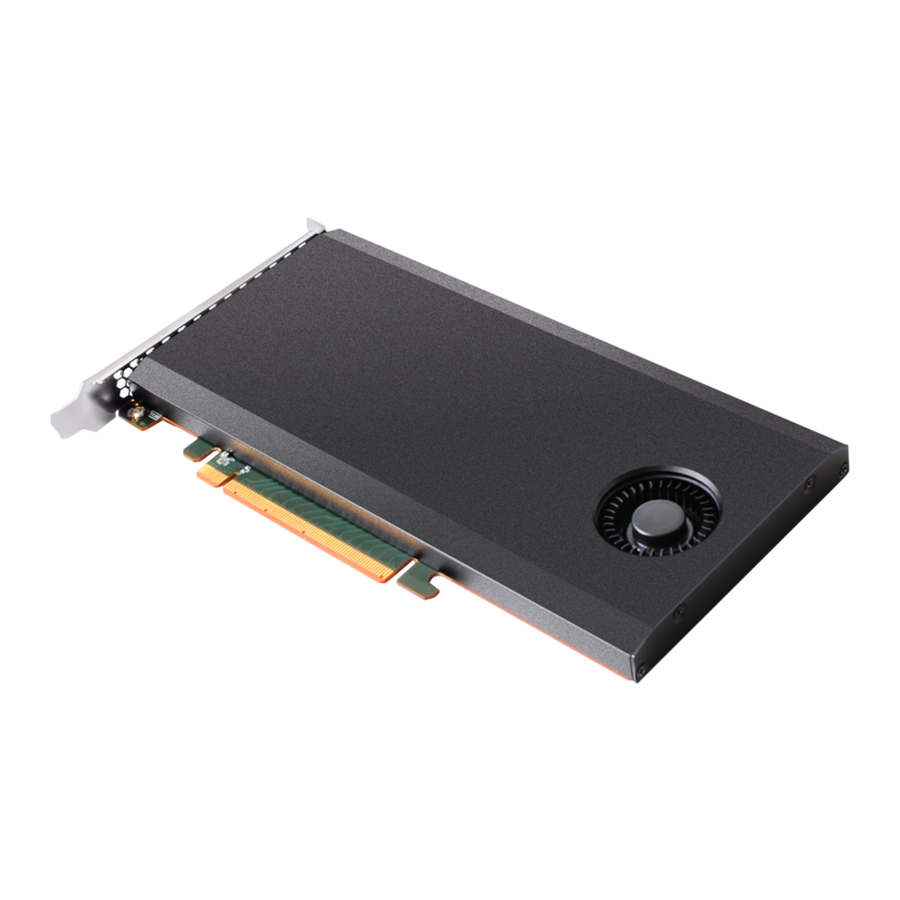
HighPoint SSD7103 Installation Manual
Nvme raid controller
Hide thumbs
Also See for SSD7103:
- Installation manual (15 pages) ,
- Quick installation manual (9 pages) ,
- Installation manual (11 pages)
Table of Contents

Summary of Contents for HighPoint SSD7103
- Page 1 SSD7103 Linux CentOS7.7 Installation Guide HighPoint NVMe RAID Controller SSD7103 Linux CentOS7.7 Installation Guide Version 1.00 Copyright © 2020 HighPoint Technologies, Inc. All rights reserved. Last updated on April 17, 2020...
-
Page 2: Table Of Contents
Step 1 Prepare Your Hardware for Installation ................. 1 Step 2 Check System EFI Settings .................... 1 Step 3 Flash UEFI Rom to SSD7103 ..................2 Step 4 Create Array ........................3 Step 5 Prepare the Driver Diskette .................... 4 Step 6 Install Linux CentOS7.7 .................... -
Page 3: Overview
SSD7103 only support EFI boot. If you have other SCSI adapters installed, you must make sure the SSD7103 controller EFI will be loaded firstly. If not, try to move it to another PCI slot. Otherwise you may be unable to boot up your system. -
Page 4: Step 3 Flash Uefi Rom To Ssd7103
Set "OS Type" to "Other OS". Step 3 Flash UEFI Rom to SSD7103 Unzip SSD7103 UEFI package to root dir (/) of a USB flash driver, and insert the USB flash drive to the motherboard; Booting from the UEFI USB flash and enter the UEFI environment;... -
Page 5: Step 4 Create Array
SSD7103 Linux CentOS7.7 Installation Guide Command with “SSD7103.nsh”, flash UEFI rom to SSD7103 Controller and reboot; Step 4 Create Array Attach four NVMe SSD to SSD7103 Controller; Note Make sure your USB flash partition format is NTFS or FAT32. Boot, in the presence of the motherboard Log screen, there will be NVMe SSD information:... -
Page 6: Step 5 Prepare The Driver Diskette
SSD7103 Linux CentOS7.7 Installation Guide Enter the motherboard’s Boot List and select start from UEFI USB flash: Command ”Arraycreate.efi” to enter the Utility: Command “create RAID0 ”. Create RAID0 array with all disks and with maximum capacity. Command “exit”; For more command usages, refer to Appendix A. -
Page 7: Step 6 Install Linux Centos7.7
SSD7103 Linux CentOS7.7 Installation Guide Step 6 Install Linux CentOS7.7 sert the USB flash drive to the target system. b. Booting from Installation DVD disc (EFI mode). c. When the Installation screen appears: If you want to choose the default system installation, please select "Install CentOS7" to install, press ‘e’... - Page 8 SSD7103 Linux CentOS7.7 Installation Guide 4.rpm In this example, type 1 and press Enter [x]/media/DD-2/rpms/x86_64/kmod-redhat-hptnvme-v1.2.13-20_03_25_el7.7.x86_6 4.rpm In this example, type c and press Enter g. After the driver is installed, type c and press Enter to continue the system installation h.
-
Page 9: Monitoring The Driver
This command will show the driver version number, physical device list and logical device list. 4 Installing RAID Management Software HighPoint RAID Management Software is used to configure and keep track of your hard disks and RAID arrays attached to SSD7103 controller. -
Page 10: Trouble Shooting
SSD7103 Linux CentOS7.7 Installation Guide 6 Trouble Shooting If you forget to install the open linux driver before updating the kernel, the system crash cannot enter. Please follow the steps below. a. Select the default kernel (3.10.0-1062.el7.x86_64)and enter the system. - Page 11 SSD7103 Linux CentOS7.7 Installation Guide Create RAID1 array with disk 1/1 and 1/3 and with 10GB capacity. <<< create RAID10 <<< create RAID10 * <<< create RAID10 * * Create RAID10 array with all disks and with maximum capacity. Delete Command...















